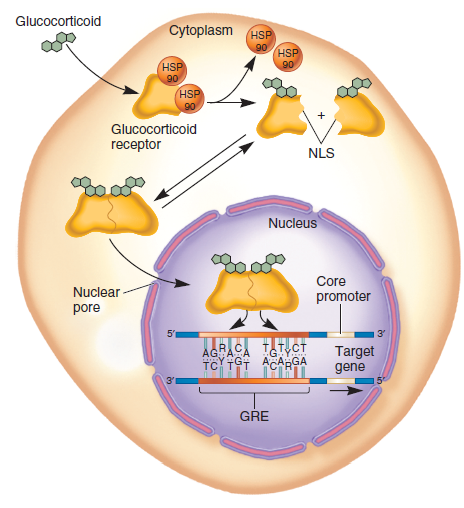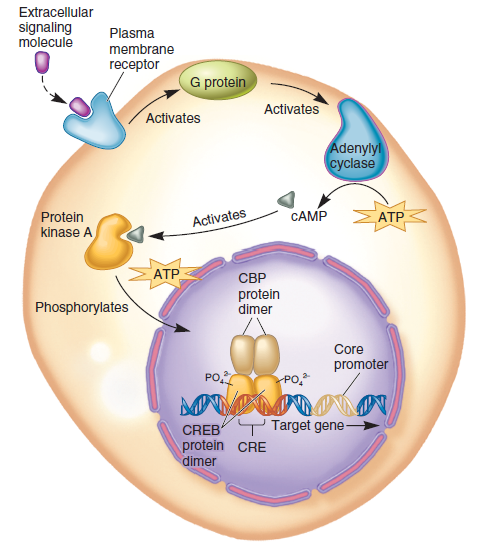
Genetics: Analysis and Principles 5th Edition by Robert Brooker
Edition 5ISBN: 978-0073525341
Genetics: Analysis and Principles 5th Edition by Robert Brooker
Edition 5ISBN: 978-0073525341 Exercise 58
As described in Chapter 15 (Figures 15.7 and 15.8), certain regulatory transcription factors bind to DNA and activate RNA polymerase II. When glucocorticoid binds to the glucocorticoid receptor (a regulatory transcription factor), this changes the conformation of the receptor and allows it ultimately to bind to the DNA. The glucocorticoid receptor binds to a DNA sequence called a glucocorticoid response element (GRE). In contrast, other regulatory transcription factors, such as the CREB protein, do not require hormone binding in order to bind to DNA. The CREB protein can bind to the DNA in the absence of any hormone, but it does not activate RNA polymerase II unless the CREB protein is phosphory-lated. (Phosphorylation is stimulated by certain hormones.) The CREB protein binds to a DNA sequence called a cAMP response element (CRE). With these ideas in mind, draw the expected results of a gel retardation assay conducted on the following samples:
Lane 1. A 600-bp fragment containing a GRE, plus the glucocorticoid receptor
Lane 2. A 600-bp fragment containing a GRE, plus the glucocorticoid receptor, plus glucocorticoid hormone
Lane 3. A 600-bp fragment containing a GRE, plus the CREB protein
Lane 4. A 700-bp fragment containing a CRE, plus the CREB protein
Lane 5. A 700-bp fragment containing a CRE, plus the CREB protein, plus a hormone (such as epinephrine) that causes the phosphorylation of the CREB protein
Lane 6. A 700-bp fragment containing a CRE, plus the glucocorticoid receptor, plus glucocorticoid hormone
FIGURE 15.7 The action of glucocorticoid hormones. Once inside the cell, the glucocorticoid hormone binds to the glucocorticoid receptor, releasing it from a heat shock protein known as HSP90. This exposes a nuclear localization signal (NLS). Two glucocorticoid receptors then form a dimer and travel into the nucleus, where the dimer binds to a glucocorticoid response element (GRE) that is next to a particular gene. The binding of the glucocorticoid receptors to the GRE activates the transcription of the adjacent target gene.
a.
FIGURE 15.8 The activity of the CREB protein. An extracellular signaling molecule binds to a receptor in the plasma membrane, thereby activating a G protein, which then activates adenylylcyclase, leading to the synthesis of cAMP. Next, cAMP binds to protein kinase A, which activates it. Protein kinase A then travels into the nucleus and phosphorylates the CREB protein. Once phosphorylated, the CREB protein acts as a transcriptional activator by promoting the binding of CBP, which is a coactivator.
Lane 1. A 600-bp fragment containing a GRE, plus the glucocorticoid receptor
Lane 2. A 600-bp fragment containing a GRE, plus the glucocorticoid receptor, plus glucocorticoid hormone
Lane 3. A 600-bp fragment containing a GRE, plus the CREB protein
Lane 4. A 700-bp fragment containing a CRE, plus the CREB protein
Lane 5. A 700-bp fragment containing a CRE, plus the CREB protein, plus a hormone (such as epinephrine) that causes the phosphorylation of the CREB protein
Lane 6. A 700-bp fragment containing a CRE, plus the glucocorticoid receptor, plus glucocorticoid hormone
FIGURE 15.7 The action of glucocorticoid hormones. Once inside the cell, the glucocorticoid hormone binds to the glucocorticoid receptor, releasing it from a heat shock protein known as HSP90. This exposes a nuclear localization signal (NLS). Two glucocorticoid receptors then form a dimer and travel into the nucleus, where the dimer binds to a glucocorticoid response element (GRE) that is next to a particular gene. The binding of the glucocorticoid receptors to the GRE activates the transcription of the adjacent target gene.

a.
FIGURE 15.8 The activity of the CREB protein. An extracellular signaling molecule binds to a receptor in the plasma membrane, thereby activating a G protein, which then activates adenylylcyclase, leading to the synthesis of cAMP. Next, cAMP binds to protein kinase A, which activates it. Protein kinase A then travels into the nucleus and phosphorylates the CREB protein. Once phosphorylated, the CREB protein acts as a transcriptional activator by promoting the binding of CBP, which is a coactivator.

Explanation
In lane 1 the 600 base pair (bp) fragmen...
Genetics: Analysis and Principles 5th Edition by Robert Brooker
Why don’t you like this exercise?
Other Minimum 8 character and maximum 255 character
Character 255



